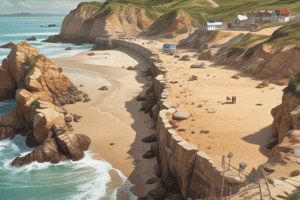Podcast
Questions and Answers
What is the main geological composition of the Holderness coastline?
What is the main geological composition of the Holderness coastline?
- Sandstone
- Alluvium
- Boulder clay (correct)
- Chalk
Approximately how much has the coastline eroded since Roman times?
Approximately how much has the coastline eroded since Roman times?
- 2km
- 8km
- 6km
- 4km (correct)
What is the purpose of the groynes in Hornsea?
What is the purpose of the groynes in Hornsea?
- To protect the sea wall
- To reduce longshore drift (correct)
- To prevent erosion of the cliff face
- To widen the beach
Why was the area around the Easington gas terminal protected?
Why was the area around the Easington gas terminal protected?
What is the name of the process that weakens the cliff face in Flamborough Head?
What is the name of the process that weakens the cliff face in Flamborough Head?
What is the consequence of the terminal groyne effect in Hornsea?
What is the consequence of the terminal groyne effect in Hornsea?
The Holderness coastline extends 61km from ______ Head in the North to ______ Head in the South.
The Holderness coastline extends 61km from ______ Head in the North to ______ Head in the South.
The coastline has eroded about ______ km since Roman times and retreats around 1-2 metres per year.
The coastline has eroded about ______ km since Roman times and retreats around 1-2 metres per year.
The area around the ______ gas terminal was protected due to its importance in supplying gas from the North sea.
The area around the ______ gas terminal was protected due to its importance in supplying gas from the North sea.
The beach in Hornsea is important as it attracts ______ and brings in revenue to the town.
The beach in Hornsea is important as it attracts ______ and brings in revenue to the town.
The ______ rock is more resistant to erosion, leaving the clay to erode and form a headland.
The ______ rock is more resistant to erosion, leaving the clay to erode and form a headland.
The ______ mud at Barmston dries up and erodes quickly, leaving a wave-cut notch.
The ______ mud at Barmston dries up and erodes quickly, leaving a wave-cut notch.
Flashcards are hidden until you start studying
Study Notes
The Holderness Coastline
- The Holderness Coastline in East Yorkshire stretches 61km from Flamborough Head in the north to Spurn Head in the south.
- The coastline's geology is composed of boulder clay, chalk, and alluvium, which contributes to its rapid erosion.
Geology of the Coastline
- The main rock of the coastline is boulder clay, deposited after the ice age as the glaciers melted with the material they had picked up off the sea bed.
- The coastline has eroded about 4km since Roman times, retreating around 1-2 meters per year.
- Flamborough Head is made of white chalk.
Key Locations
- Flamborough Head: composed of resistant white chalk, eroded to leave a headland due to hydraulic action, bedding planes, and joints.
- Barmston: area of weak cliff due to mud and dried sediment, prone to erosion, with a failed attempt to protect the caravan park using boulders.
- Hornsea: a tourist town relying on income from tourism, with multiple caravan parks, golf clubs, arcades, and a promenade.
- Hornsea's Protection Methods: includes sea wall, rock armor/riprap, and groynes to reduce longshore drift.
- Hornsea's Beach: crucial for tourism, but threatened by terminal groyne effect and erosion, which accelerates erosion further down the coast.
- Easington Gas Terminal: a small village protected due to the strategic importance of the gas terminal, which supplies gas from the North Sea.
- Spurn Head: a salt marsh area to the west, serving as a bird habitat, with a lifeguard station, lighthouse, and small settlement, but with abandoned defenses.
Studying That Suits You
Use AI to generate personalized quizzes and flashcards to suit your learning preferences.




